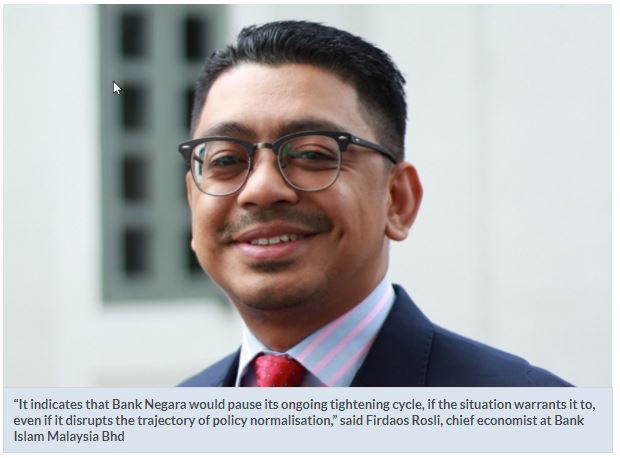Malaysia: Fourth 25-bps rate hike to 2.75%
PETALING JAYA: Bank Negara’s Monetary Policy Committee (MPC) has raised its benchmark overnight policy rate (OPR) by 25 basis points (bps) to 2.75%, with the central bank stating future policy action need not remain on the linear trajectory seen in 2022 and balanced by the need to contain inflationary pressure and sustain economic growth.
This was the fourth consecutive 25-bps hike in the OPR this year, with the central bank asserting strong economic growth provided the room to do so and the move yesterday driven partly by the elevated headline and core inflation levels.
The central bank reiterated the MPC was not on any pre-set course, which economists interpreted to mean the central bank maintains its policy autonomy and would be primarily data-dependent in determining the OPR, going forward.
“It indicates that Bank Negara would pause its ongoing tightening cycle, if the situation warrants it to, even if it disrupts the trajectory of policy normalisation,” said Firdaos Rosli, chief economist at Bank Islam Malaysia Bhd.
In its statement yesterday, Bank Negara noted that despite the challenging environment, domestic demand will remain the key driver of economic growth, with household spending underpinned by improvements in labour market conditions and income prospects.
It said tourist arrivals will provide a further boost, while investment activity and prospects will be supported by the realisation of multi-year projects.
The central bank added that external headwinds could dampen the vitality of current growth, more so if global growth slows above expectations due to various reasons.
Phua Lee Kerk, head of research at Phillip Securities, said Bank Negara still faced two major issues, namely, inflationary pressures, not from overheating but from higher natural resources prices, and the rising interest rate differential which is leading to the weaker ringgit and import inflationary pressures.
“The inflationary pressures will remain for the moment because commodity resources prices remain elevated, but the 25-bps hike in the OPR will help stem the further weakening of the ringgit temporarily as markets await for policy trajectory into 2023 from Bank Negara and the Federal Reserve (Fed),” he said.
Bank Negara’s move comes on the heels of the Fed hiking its policy rate by another 75 bps to the range of 3.75% to 4% yesterday to cool inflation at four-decade highs in the American economy .
More important was Fed chair Jerome Powell stating the runway to a soft landing of the American economy had narrowed over the course of the year with a recession increasingly inevitable.
He warned reining in the sticky and high inflation was proving to be difficult to the extent rates have to go higher and stay higher for longer.
The Fed’s move has widened the interest rate gap between the United States and Malaysia, and has been the main factor pushing the ringgit to record lows which is unlikely to recover anytime soon, said analysts.
Following the latest rate hikes in the United States and here, the ringgit hit a multi-decade low of RM4.746 to the dollar yesterday before closing at RM4.742.
Firdaos believes Bank Negara is acutely aware of the rate and yield gaps between Malaysia and the United States amid the latter’s aggressive monetary tightening, adding financial markets will remain volatile as the divergence in monetary stance gets wider in time.
“I believe Bank Negara is steering clear from tightening the OPR as aggressively as in advanced economies.
“Thanks to subsidies and price controls, Malaysia’s inflation rate remains relatively benign compared to advanced economies, although imported inflation remains a challenge amid a strong dollar environment. Malaysia’s real interest rate is evidently higher than in advanced economies, including the United States,” he said.
The rate differential has driven outflows from the local bond market but offset partly by inflows into the equity market. The country’s international reserves have fallen from about US$116bil (RM550.3bil) in January to US$104.5bil (RM496bil) as at Oct 14, which is a trend similar to many countries as the dollar assets become safe havens.
The country’s reserves however remain at comfortable levels and adequate to pay 5.5 months of imports of goods and services and is 1.1 times the total short-term external debt, Rosli said.
From the real effective exchange rate’s perspective, the ringgit is undervalued which makes Malaysia’s exports and FDI into Malaysia more attractive, assuming the right policies are in place, he added.
Bank Negara expects headline and core inflation to stay elevated amid both demand and cost pressures and from possible changes to domestic policy measures by the government post GE15.
“We are in the same tune with Bank Negara, especially the stance of the post-GE15 government on a fuel subsidy policy which will determine the direction of Malaysia’s inflation outlook for next year,” MIDF Research said in a report yesterday.
With the rising core inflation trend and stronger-than-expected domestic demand, MIDF expects the central bank to front-load its monetary bullets to pre-pandemic levels of 3% by January next year when the MPC meets again.
“The decision will be subjected to the stability of economic growth, the pace of price increases and further improvement in macroeconomic conditions, particularly a continued recovery in the labour market and growing domestic demand,” MIDF stated.
From a medium-term perspective, the policy rate normalisation is needed to avert risks that could destabilise the future economic outlook such as persistently high inflation and a further rise in household indebtedness, it added.
Source: https://www.thestar.com.my/business/business-news/2022/11/04/fourth-25-bps-rate-hike-to-275


 Thailand
Thailand




